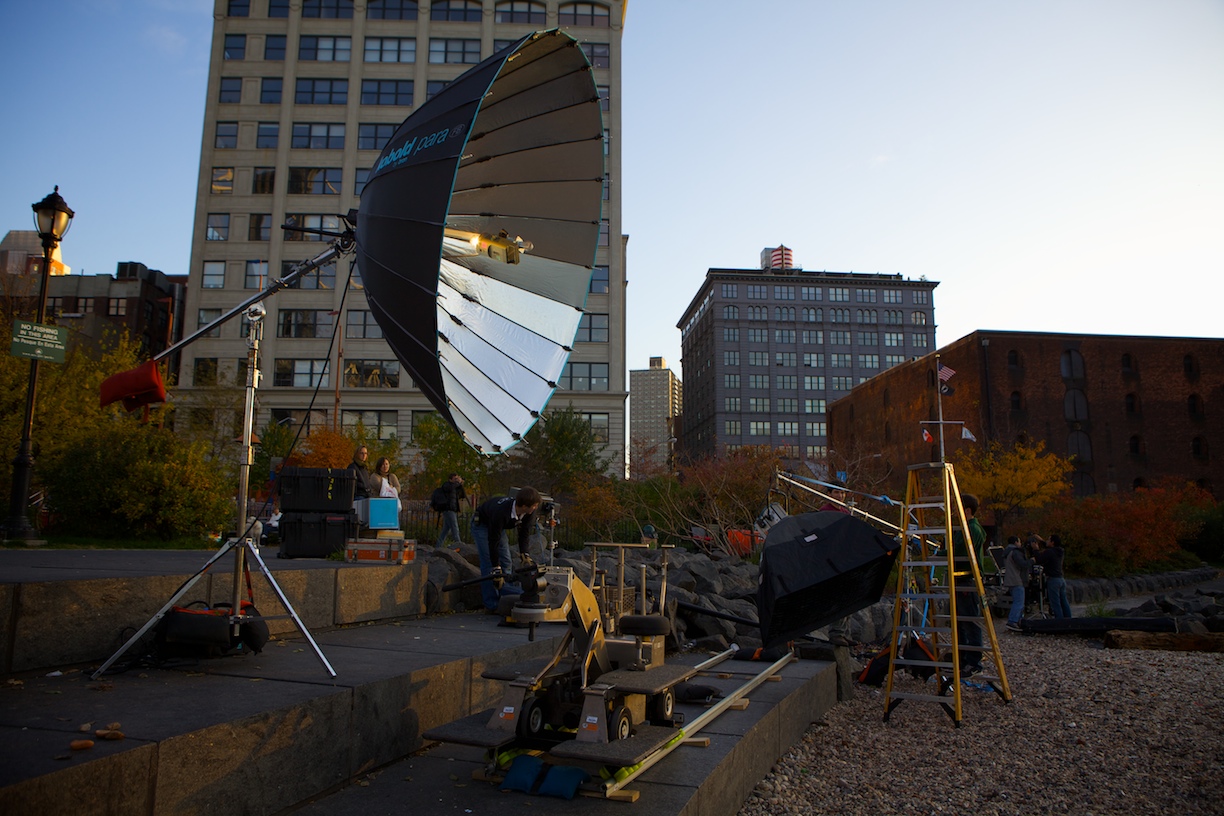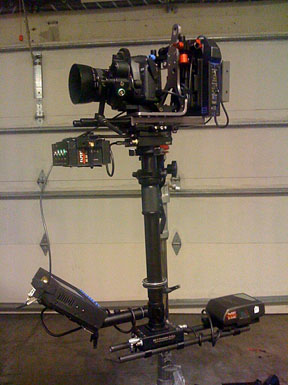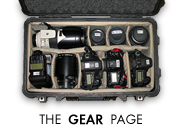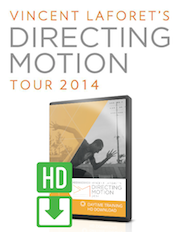Hidden Dangers of New Technologies
 I’ve been debating a bit on whether or not to post this one – but I think it’s necessary – so here goes:
I’ve been debating a bit on whether or not to post this one – but I think it’s necessary – so here goes:
New technology is great. It allows us to do things we previously thought impossible. It empowers us to “push the envelope” if you will.
That being said, one of my favorite axioms came to mind after I read the PDN Article at left, namely: “Just because you can – doesn’t mean you should.”
First – I should say that I don’t know Jason Lam (the person selling these helicopters) nor is this aimed at him or critical of him. Jason has EVERY right to sell his services and helicopters – unequivocally.
But I do think it’s a tad bit irresponsible for PDN (and perhaps Jason’s site as well) to fail to mention two very key things in their article/site:
1. Flying a remote control helicopter over New York City (as in the island of Manhattan) is ILLEGAL. (w/o a special permit – which is virtually impossible to obtain due to safety concerns.)
2. It’s extremely dangerous to fly such a helicopter (1. in general and 2. especially over a heavily populated place such as NYC.) Think of a flying blender if you will… if the operator/pilot makes a mistake the thing will crash or worse maim someone.
God forbid an errant radio signal interferes with the helicopter’s signal and the thing goes haywire (these things don’t exactly float down if you catch my drift.)
What I’m trying to say is: you can kill someone (or yourself) if you don’t know what you’re doing. Trying to fly a helicopter and trying to take pictures as well – is more that twice as dangerous!
OK – so let me back down a bit. First I know that PDN is simply listing this new piece of kit as they would any other piece of equipment. Jason Lam is also selling his services. Both have EVERY right to do so.
What bothers me is that I haven’t seen a SINGLE mention anywhere on either of the sites that relates to how dangerous these helicopters can be when put in inexperienced hands.
I felt the need to point this out, because as many of you may know, I employed the services of an RC helicopter and it’s pilot, Tabb Firchau during my filming of the Jamie O’Brien doc earlier this year. I show this video during many of my seminars – and someone will invariably run up to me at the end of my talk and ask where they too can buy such a helicopter ASAP… and I tend to cringe a bit.
I think it’s important for me to mention that Tabb flies REAL helicopters (the big ones) and has done so for well over a decade. He’s put in thousands of hours to hone his skills as a pilot of big and little helicopters. Therefore he’s put enough practice into it to safely be able to fly and shoot with these little technological marvels.
I myself have landed a small plane (I started but never completed my pilot’s license) and have hundreds if not thousands of hours in flight simulators. Yet I’ve never set my hands on another friend’s RC helo remote… I haven’t even asked out of respect. Why? Because when you start to fly RC helicopters – it’s not a matter of if, but how soon you will crash it. This is the same reason that while I am a certified Rescue SCUBA Diver – I refuse to shoot and dive without a dedicated person who is more than just a “dive buddy.” It’s simply too dangerous to try to balance the two simultaneously without a LOT of practice.
So I felt responsible for saying that – I hope that’s OK.
On a final note: as these new technologies continue to role out – it’s important to realize that our most valuable asset are the people who know how to use them best. I.e. our most valuable assets are skilled people – i.e. professionals. That too often seems to get lost as everyone seems to think they can do it all “themselves” as they become instantly “empowered” with these new gadgets or technologies. I think that while we should all jump at the change to take full advantage of these new things – we should remember that we need to be responsible in doing so. We need to remember to do our research – to learn about them and treat them as a craft – especially when safety concerns are present.
Therefore if you’d like to fly your DSLR below and RC helicopter – I suggest you hire a professional like Tabb to fly the helo for you. The same goes for pretty much any other thing in the industry: i.e. if you want “fly” your DSLR on a Steadicam – I suggest you hire a great steadicam operator and 1st AC/Focus puller – they are worth their weight in gold. (More on that in a later post.) If you want to do it yourself – don’t forget that mastering these things takes weeks if not years of experience, and that hiring a professional will save you an incredible amount of time on any production for example – i.e. good people pay for themselves very quickly…
That’s enough for now – I’m starting to sound like a pamphlet…
— 20 minutes later —-

To some... this scene may look a wee bit familiar... this time it's safe to say the crew and technology was a wee bit more advanced than "Reverie" a year ago (the shot above was made last night)- but on the same spot... more info to come on this shoot as soon as I can release it!
Oh heck… I’ve been meaning to write about this for a long time as well – so here goes:
These days we’ve all been feeling the budget crunch. While things definitely feel like they’re getting better in terms of work these days – I’m worried about the long term effects of the budget crunches (will they ever go back up once they’ve been squeezed down?)
That’s a whole other post – but there is one thing I do want to say: if you need to cut back on things and to make space in your budget, I would suggest you do the following:
Use new technology to help you cut costs – i.e. the new DSLRs will help you save money b/c they are more sensitive to low light – and you won’t need as much light as you might previously have needed (in some situations of course – not all.)

Bron's Kobold Para's series of light modifiers are a new favorite - basically they are one great solution to reproducing the type of light that every still photographer would associate with an Octabank. The Para can do strobe, continuous light - and either Tungsten or HMI light... A/C or battery operated.
So perhaps you can spend a bit less on your lighting package now.
Here’s where you should NOT skimp: PEOPLE.
This is such a basic thing that we all know – but it never hurts to repeat it – especially these days.
Just last night – I was shooting the intro piece for an upcoming show on network television in NYC (more to come on that when I can release it.) The best thing that I did was to hire a top Steadicam operator (and DP) Charles Papert (who I flew in from LA) and a top notch 1st AC/Focus puller Walter Rodriguez (who is NY based.) I spent a good part of my production budget on those two gentlemen – and I don’t regret it for a single second. Why?

I have access to a Glidecam – and several operators that I know in the NYC area were available with their own professional rigs.
But Charles and I have worked together to get his rig working with lots of very cool gadgets (wireless focusing rigs, wireless video transmitters etc.) and we have the system down.
During yesterdays’ production – things went off without a single hitch (amazing given that we have a lot of custom-made pieces that we threw into the mix.)
The Steadicam work was flawless on Charles’ part, the focus pulling dead on – and we were able to go from shot to shot – nailing them on the first or second try, time and time again. Even better – we were able to push the envelope not just technically – but artistically… when the producer tells you you’ve got the shot on the fist try with a huge smile… instead of begging for more time for fix what could have been a bad first take – you don’t hesitate to suggest you try something more original or daring on the second take…
Spending that extra bit of money on Charles (and flying him cross country) and Walter was worth every penny in my book. Because we had close to 30 people on set – and 7 “talent.”
When you think of how much money you’re losing every single time you miss a take because of the operator’s inexperience (either in terms of their personal experience level – or their familiarity with the (often prototype) gear) you realize that they pay for themselves within the first 15 minutes they are on set.
Had to say that. I hope it’s received well.













Vincent,
I agree with your points on the safety aspect of RC aerial photography. I myself have for many years flown RC helicopters with DSLR’s under them, and you’re right it takes years to learn.
They are basically an inverted lawnmower!
The PDN article may have been a bit irresponsible in their article, but to Jason’s defense with regards to your point #2 above, his website does address safety, and the amount of time it takes to learn to fly on the lower half of the homepage at listed below, he even recommends hiring a pro to fly it for you.
http://www.aericam.com/
“Can anyone fly a SkyShutter AeriCam?
Although the SkyShutter AeriCam is nimble and easy to maneuver, flying a RC helicopter is generally no simple task. In fact, it is one the most difficult aircrafts to learn to operate, as the spinning blades are especially dangerous. Typically, hundreds of hours of experience are needed to learn how to fly and to properly maintain a RC helicopter. However, with time and patience, the SkyShutter AeriCam can be mastered to meet all needs in RC aerial photography.
What if I don’t know how to fly a RC helicopter?
Not a problem! To ensure your success in RC aerial photography, we highly recommend SkyShutter’s extensive network of aerial RC pilots, all of who have extensive RC pilot experience. For image makers, the option to partner with aeriel RC pilots is the best guarantee to capturing aerial imagery.
Alternatively, we also recommend computer simulation RC helicopter flying on your personal computer. With the availability of the simulator at your finger tips, you will greatly speed up the learning process. Once you can comfortably manage flying in the simulator, then you can apply your skills to flying a smaller, less expensive model.
For a slightly higher cost, a flight stabilizer can be installed to further ease the challenge of flying. Another option is autonomous flight stabilizer units, most of the flying, auto landing and taking off can actually be done by way point.”
Agreed completely!
Anytime I have done aerial photography, I insist on taking not only the pictures, but flying the craft be it a helicopter or plane, as well as eating a sandwich and talking on my cell phone. Call me a multi-tasking, hungry, soccer mom, photographer kind of guy….. 😉
In all seriousness though, you are right, there does come a point where you should be smart enough to hand over the reigns to someone who is more capable to make your job a bit easier. I mean, I have sewn a button or two back onto a shirt here and there, but if I sliced my leg open, that doesnt mean I would try and stitch myself back up.
Hello M. Laforet,
Your remark is full of common sense.
I want to belive that everyone who have been amazed at what a combinaison of HD-DSLR and those RC heli can do, also fully understand the danger of using those and the hundreds of hours of practice and multiple (and expensive) crash that it will take for a proper use, even in a remote area !
At my low, amateur level, I have been looking at this kind of technology for a few years and hope we will find a good solution for the creative amateur with small zeppelins.
That technology is much safer, you can set the small motor to off if you loose radio contact, and it will not drop kilos on someone head. Also you can keep it manageable with a rope. It is a lot of stuff to move by car but it is pretty safe.
With the new interchangeable lens compact we see comming, we can keep the weight to a reasonable level. Think about a kind of cheap GF1 + 18-55IS or a cheap 14mm 2.8, that you can take up to 20 meters above your head – because for sure it is nice to do aerial photography but the range between 3 meters from ground and 20m could be extremely interesting I think.
For sure this solution already exist but the price is still very high and only basic compacts could be taken on, with poor optics and costly and limited live view. Soon our interchangeable lens compacts will have a wifi version of the latest, very nice live view sytem.
Then we will have a great improvement in quality, cost and usability from current models. Many may be able to avoid the RC heli thanks to that.
Just my 2c
Alain
Flying an RC helicopter is essentially impossible until you can do it. Those who can’t, but are stupid/ignorant enough to try, will find themselves, after about 10 seconds, with a very expensive pile of junk (and maybe a few severed heads), so it’s sort of a self-policing issue. 🙂
If you’ve never tried, watching someone do it makes it look effortless. A kid could do it! Few things humble more than trying it for the first time.
Good post.
Come on Vincent. Okay, so it’s dangerous to fly a RC helo. But it’s not the job of the reporter to tell people that in a product report from a trade show.
You did a video last year from a helicopter, didn’t post a warning about how dangerous it is to be in a helicopter. After all, one collided in the NYC skies with a plane and everyone died. I don’t remember the last time I heard a report that a RC helicopter killed someone.
And your even say you use on in class and then people come over to find out where they can buy one and you cringe. Shouldn’t you tell them first it’s dangerous? Demonstrating one in use is more likely to inspire a purchase than mentioning they’re available.
Dan wouldn’t have needed to warn people that DSLR rigs that mount to a car are dangerous because they can distract the driver or that you shouldn’t use a cell phone to take a photo while driving if there was some product that does that.
Likewise, you don’t have to mention that the big heavy lights you show later in your post might fall over and hurt someone, or that shooting right next to the water with generators and high-voltage gear could lead to harm.
Now if he were writing a tutorial on how to do it, sure, I’d see that. But not in a product listing from the floor of a trade show.
But I still love you Vincent.
Wolfgang Lienbac.. Reply:
October 31st, 2009 at 1:02 pm
@David Schloss, hey David. As I posted below, rc-helicopters are a little different to driving a car of watch out for heavy lights falling. They are a lot more fragile, and need a lot more of skill to operate than a car. If you’re perfectly familiar with what you’re doing, it’s a different story tough.
Vincent did warn about the dangers in every post regarding helicopters, I can remember that quite clearly.
cheers,
Wolfgang
Vincent Laforet Reply:
November 2nd, 2009 at 1:47 am
@David Schloss, David – actually I disagree with you completely. If a reporter writes a review of a new taser gun in a gun magazine – I wouldn’t expect that reporter to write any disclaimers with said article. However if s/he is writing about the Taser gun for Oprah Magazine – it would be irresponsible for that writer not to cover the basic risks / legal ramifications in that article… right?
As was posted below – I DID post a warning about how dangerous it was to fly the RC helicopter when I posted the JOB piece as mentioned in the comments by someone else.
The helicopter pilot and his passengers were killed when the other (non-professional) pilot made a mistake and struck him from behind btw.
I think it all depends on who you are writing for – that’s the point. If you write for a trade mag about a piece of kit FROM THAT trade – then you’d have a vaild point.
In this case I’m afraid you’re pretty thin. No hard feelings here – I stand by what I said and respect Dan very much and hold him to the same standards I would hold myself to or any other reporter that I worked w/ at the NYTimes btw. I stand by what I said.
You should mention that you once were/are a colleague of Dan’s at PDN Magazine too – so that people know where you are coming from on this.
Hey Vincent,
Its been a while since I saw you at the Maine Media Workshops this summer. Glad to see you are still making impressive movies. Im curious about the steadicam setup that you were using, particularly the wireless focusing aspect. I have a shoot coming up that wants steadicam and wireless focus on the 7d. Were you using a Preston or a Bar tech or something else? Im having a tough time finding anything on the net so any response would be awesome.
Thanks again
Hey Vincent, thanks alot for pointing out that danger. I really just can repeat what you said. I always wanted to have a rc-heli since I was a child, and a couple of months ofter you published the video with the 5D on the heli, i got myself a small one for learning purposes.
Let me say that straight how it is: if you haven’t ever flown a Helicopter, don’t buy one and think you will manage that. It took me 3 weeks of daily practice (!) to get it fly eights in circle, and they were far from safe, it took a whole week (daily practice for severy hours!) just to get it hover somehow safely. Now after almost half a year of daily practice in at least a simulator I can say: well now i might be good enough to carry a camera. But this is only half of the story: If you learn flying RC-Helicopters, it’s not only about learning how to fly! It’s EXTREMELY IMPORTANT to know every single part, every screw, every bearing and every ball-link, you NEED TO KNOW why this thing flies, how it flies, because a lot of things can happen in flight that will make your helicopter crash. This is nothing you can buy in a shop, this needs time and dedication.
Next thing: I’ve got myself a small 450 size Helicopter (about 70cm rotor diameter) for practice. This little helicopter spins his rotor with 3000rpm (!!), if you put your finger into that spinning rotor, you had a finger. These little thingies are extremely dangerous, if not operated correctly, or if something fails. You wouldn’t mount a camera on a Helicopter of that size though. Normally you would mount it on a helicopter with about 1,6m Rotordiameter (That’s the 90 class), with the Blades weighing more than 200g, spinning with about 1800rpm. If you can do a little bit of math you will see that these blades could chop your head off with no problem!
Having that pointed out: It is possible to get a camera-helicopter airborne safely. In our times it’s even easier than ever. The newest generation of electrically driven Helicopters are very safe and very powerfull (more powerfull than nitro powered helis!), if operated correctly. But there is so much you need to know about RC-Helicopters. You would need at least a Year to be able to operate it safely, if you develop it full time. And then you’re still a greenhorn, that is very prone to making mistakes.
Now, after about three quarters of a year, I began building up my camera helicopter, and i bet it will take another 6 months until it’s ready business. You can’t buy and fly helicopters like these out of the box. There’s tons of adjustments to make, you can’t make these without RC experience at all. Cool think about my camera helicopter: It will have 2 seperate Video-Downlinks, one for the camera-operator, and one for the pilot. The pilot will have Videoglasses with telemetry overlay, and a gyro on his head, that transmits his head movement to the helicopter, which will move the pilots microcam according to the pilots head movement. In my opinion this is the only way to fly the helicopter precisely and safely (with a spotter on ground, that can take over the helicopter in emergency). But that way of flying a rc-helicopter is very new, and still needs some development to do.
So if you plan to get one of these helicopters, make sure you have enough time to make it right. Plan at least a year of your time, until you’re ready for business. Everything else would be very stupid and might kill someone.
best wishes,
Wolfgang
I wanted to chime in here and share a few thoughts as well. Firstly I am an Entrepreneur at heart and I love to see people innovating and have no problem with people selling these innovations. This is part of what I love about this industry, the creative people always pushing it forward combining new gear with artistry to create compelling work. That said I do have a problem with people thinking about Remote helicopters as toys, this stigma makes then seem innocuous and harmless. This is far from the truth, when I am on set with the remote helicopter it is probably one of the more dangerous tools there if you do not give it the respect it deserves.
These remote helicopters are orders of magnitude more difficult to fly then full size helicopters, and I feel like any article that capitalizes on how cool they are and the amazing imagery they can obtain without mentioning the dangers is doing the industry a disservice. I always cringe when I see an article on remote imagery that does paint the full picture of how dangerous and complicated these machines are. It took me years of constant practice to be competent enough to fly a remote helicopter with a camera onboard, and years after that to be skilled enough to fly the complicated maneuvers that productions often desire.
I agree with Vincent as well about hiring professional and respecting the skills that they have acquired over many years. On a recent job we had some down time and I convinced my friend Hugh to let me try his steadicam out. lets just say Garret Brown would have been appalled with the results. There seems to be an attitude in todays culture of ” Oh, I can do that….no problem” and the truth is….Yes you probably can do it, but only after you put in the 10,000 hours to truly master whatever skill you are after.
I get calls daily from people that want to get in the remote chopper business….and I am all for it. The more the merrier, all these new entrants push the industry ahead and I am sure will develop technology that brings our work to the next level. That said I am very clear with them that they will at the minimum dedicate 2 years to constant practice and likely spend upwards of 50K on helicopter parts/crashes to get to the point where they can safely and reliably fly a camera around.
Please be careful with these tools and happy landings!
Tabb
I listened to his pitch at PhotoPlus Expo. He was quite clear about safety and the need to have significant training under the belt before even attempting a flight and how having 2 operators, an experienced pilot and a separate person operating the camera was strongly recommended. He gave a sober picture of the requirements probably to the detriment of sales.
Even if he doesn’t have big notices like “Please go away if you’ve never flown a RC helicopter” I still think his intentions aren’t to put these in the hands of newbies to make a buck and to hell with anyone who gets hurt. Anyone calling him and thinking of buying one of these is going to have an at length conversation with the guy and hear what I heard. It won’t be click “add to cart” and open up the UPS box, walk up to the roof and fly over New York City.
We should celebrate entrepreneurs and innovators. Aren’t we all a bit guilty of inspiring people to have careers in photography which might be dangerous. By this logic PDN have notices that say, “warning this war photography may inspire you to have a career in photojournalism and you may die in Iraq”. Many of your points are valid but I think it’s a bit strong to condemn the article for not running it through legal to add the right disclaimers typically found in tiny type.
No doubt Vincent. I looked at the rig at PhotoPlus and thought, wow, somebody is going to get hurt. Anyone considering buying an RC needs to buy a computer flight simulator and a remote first. Then they will fully understand just how difficult flying an RC really is. Also, it is MUCH cheaper no matter how you look at it, just to have an expert operator fill in those few blanks of a production.
I only recommend buyers to partner with experienced pilots. This is the only solution that I see possible working with RC helicam. The whole time in the EXPO and to any potential buyers, I tell them that it’s a 2 person operation, if you are interested in the photography, be the camera person. And either I can refer someone to help you fly, or find an experience pilot in local flying field to help you fly.
It was never intended to sell the AeriCam and tell them go out and fly.
Jason
Vincent Laforet Reply:
November 2nd, 2009 at 1:54 am
@Jason Lam, Hey Jason – truth be told – like I said in my post above – you have EVERY right to do what you’re doing…I was taking a bit of an exception with the article. I would say two things: 1. if you are selling your services – then why do you also sell the RC helicopters on the same site??? It sends a bit of a mixed message to me that’s all.
Lastly – I’ll tell you what got me thinking – it’s the video you promote on the link below: did you ask permission from all of the people on the soccer field before flying over them? Do you think that doing so should be necessary? It’s one thing to fly over actors / models who are on a job and aware of the risks – but what about kids / people playing soccer in a public field? Let me know what you think of that – am I out of line? One my say that I do the same thing when I fly a (real) helicopter over a city – but it should be mentioned that the mechanical checks, safety standards we observe while flying, and skill of the pilots is SO MUCH more regulated than what people need to be RC pilots.
Thoughts anyone? Below is the video in question – I hope the link works. If not you can find it on http://www.aericam.com/
Aerial Photography New York from Jason Lam on Vimeo.
Hi Vincent, After reading your article I can understand your position of the fear of the unknown to you. It actually goes both ways in that there is another train of thought that appears to be oblivious all together of the safety concerns for this venture. The best way to form a valid opinion if you want to share one would be to develop your experience directly. To voice opinions from the side of the observer is like empty calories from your suppers dessert. It may taste good but it is of little valuable content other than the suggestion of fear in fellow eyes of the unknowing. I agree with several of your points in that experience is key when operation one of these little machines. I myself have been working toward perfection now for 25 years. I still don’t think I have it all sorted out yet. By that I mean there is always more to learn. As Tabb described every practice takes 10k hours of development for a person to become masters. I have been personally instructing new people who wish to learn this type of machine since 1995. In that time I’ve seen many people start stop and go into different directions. Usually with the idea that it is not so hard and they can just do it. I believe that is universal in our society as stated before. I would suggest to anyone in hiring a pilot and operator of this type of machine that they look for a qualified person with no less than 3 years of general radio controlled flying experience and 2 years radio controlled camera helicopter experience as well. That would be a minimum in my experienced opinion. The person should also have been and understudy for most of that period of time from a credible master of this field. One should be aware that the general rc sport helicopter provides a substantial amount of practical experience that the camera helicopter differs to in that it is much heavier and takes a substantial amount of more time to learn how to compensate for the heavier loads and weight that increase the room needed to start stop turn and overall maneuver a heavier helicopter.
Referencing this as a new technology I feel would not be an inaccurate statement. The first camera pilots began as early as 1984 and possibly prior to that. The first functioning active rotor helicopter kit was sold in 1978 by GMP products and designed by the late John Gorham. Where most product in the industry of cameras is considered current at less than 3-5 years of age I would think by contrast comparison that this would not qualify to be considered a new technology at this point anymore with these years of operation. Most people think FPV flight or First Person View flight (flight by video stream via radio signal) is new. Robert Gorham Jr. used this in the Robin Williams movie Toys (1992). This movie referenced a toy helicopter that flew down a hallway and made a 90 degree turn searching for the characters all by FPV operation. All that with only 16 inches of clearance from the rotor edge to the set wall. Just a little movie fact. I not only practice this operation but I study from my predecessors too. That is really where experience comes from. A draw of all possible understanding from practical and direct study in this field.
I illuminate these points not to be inflammatory but to shed light on a perspective that really needs to be clearly understood. This work I love and it should be carefully used by experiences of Par and not the novice. In 1982 there was also an accident on the twighlight Zone set involving a full size helicopter that killed 4 people including the actor Vic Morrow and two children. We can now use these small rc helicopter camera machine to cover the same perspectives for production with almost surgical precision depending on the experience of the pilot and team members involved. These small machines dramatically enhance any directors ability to portray the desired vision we all hold so priceless and do so while dramatically improving saftey.
Vincent Laforet Reply:
November 2nd, 2009 at 1:57 am
@Eric Pacheco, Eric – if an experienced pilot is flying the RC or real helo – I’m cool. When novices are invited to try not one but two very difficult things at once – I find it a bit unsettling. And you missed the point: it’s not the RC helicopter that is new – it’s the high quality DSLR cameras that can shoot 1080p video that are.
Also, a lot of people miss my point. I really want to put these machine in the hands of creatives, not to have them fly, but have them be the creatives. Same way when medium format digital cameras came out, you need a digital tech by your side to ensure the technical aspect is taken care of, while the photographer can relax and concentrate on doing the creative aspects of things. Same way like Full Scale Aerial Photography, you need a pilot and a cameraman.
I am not trying to sell to photographer and have them fly it. The idea is to own these machine and either partner up, or hire a RC pilot to do flying, which will cut down the cost and you can fly whenever.
I really feel, aerial is a the dimension few photographer ever have the opportunity to explore. Imagine that you don’t have to think about $500 to $1,500 an hour renting a helicopter and you are not bound to creating these images with in the 1 to 2 hour time frame of your rental. You are the owner of a flying camera, you have the flexibility of shooting aerials whenever, 24/7.
Traditional, Aerial photography is only use when you have a production with a huge budget. I really want to photographers have the opportunity to play and experiment aerial photography, like you play and experiment with a digital camera. That’s when true art will be created.
My goal is to see this art taken to a whole new level.
Aerial photography in Utah is a method of photography wherein subjects are taken from great heights.
Thanks so much for broaching this subject Vincent.
So to summarize, not everyone can or should be an astronaut, navy seal, formula one driver or circus performer. For most of the same reasons, not everyone can or should attempt be an RC helicopter aerial cinematographer. Seriously kids, don’t try this at home.
It’s for good reasons that people don’t trust their lives to commercial airline pilots who don’t have decades of experience. This is no different and possibly even more demanding because the airline pilot isn’t also the required to be the chief mechanic.
Furthermore, when someone who has been doing something for 30 years tells you that it is much much harder (and more expensive) than it looks, you should listen.
Good post, Vincent. AP operators are in a precarious position these days with the FAA breathing over our shoulders. It shouldn’t go without saying that “we” operate as professionals, and should expect others to be professional too. It has gone without saying my many individuals that what we do is dangerous. Anyone can buy a “toy” helicopter and dream of putting a camera on it, but only years of experience will make that operator safe. Yes, years. There is so much that goes on with remote control helicopters that simply can’t be learned in a few short months of “training” or learning to fly.
This article is pretty amazing to me. “Hidden Dangers of New Technologies” One should wonder why Vincent feels the need to rant on about the dangers of flying RC crafts? More people are killed flying full scale craft than any RC aerial model. Vincent, I know your aerial work well and I personally feel this is an attack because you feel threatened by the ‘not so new’ technology…if Jason’s business operated outside of NYC, let’s say Idaho, would you have entertained the thought of blogging about it? doubt it. On Jason’s site he clearly writes about safety. Now on the flip side, you have a point about flying over populated areas and I’m against that unless it’s staged but to totally bash the art of RC aerial photography without any actual incidents of anyone getting hurt or killed in a populated city environment (uh oh I see Google search happening right about NOW) is kind of a let down to me…I want to see blood and gore. In closing this is an amazing art that should be done by experience RC enthusiast and the unique multimedia that can be had is quite amazing!
Vincent Laforet Reply:
November 2nd, 2009 at 1:24 pm
@Mr. Greggs, I live in Los Angeles now…